Scholastic Bundle
Can Scholastic's Growth Strategy Propel It to New Heights?
Scholastic Corporation, a titan in children's publishing and education since 1920, is undergoing a significant transformation. From its roots as a provider of educational materials, Scholastic has evolved, recently making a bold move with the acquisition of 9 Story Media Group. This strategic shift signals a pivotal moment for the company, expanding its reach into the dynamic world of children's media.
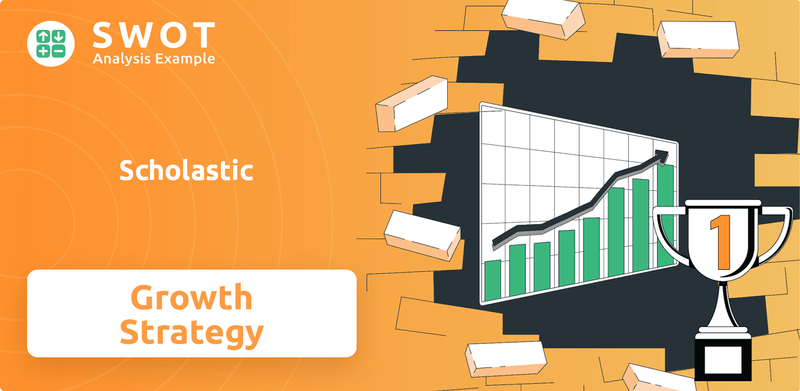
This Scholastic SWOT Analysis delves into the heart of Scholastic's evolving business model and its ambitious expansion plans. We'll dissect the company's recent acquisitions and their impact, analyzing its financial performance and future prospects. Understanding Scholastic's competitive landscape and navigating its challenges is key to assessing its long-term growth potential in the digital age and beyond, making this a crucial read for anyone interested in the publishing industry and the future of children's literacy.
How Is Scholastic Expanding Its Reach?
The Scholastic growth strategy is centered on expanding its market presence and diversifying its offerings. This involves strategic acquisitions, new product development, and leveraging its established franchises. The company is actively pursuing opportunities to enhance its position in the children's content market.
Scholastic's future prospects look promising, driven by its focus on key growth areas. These include the expansion of its entertainment segment, the continued success of its core publishing business, and the growth of its education solutions. The company is also investing in digital platforms and online learning to meet evolving market demands.
A comprehensive Scholastic company analysis reveals a strategic approach to growth, combining organic initiatives with strategic acquisitions to strengthen its market position. This is reflected in the company's recent moves and future plans, which aim to capitalize on the evolving landscape of children's content and education.
Scholastic is focusing on entering new markets to broaden its global reach. This includes expanding its presence in both established and emerging markets. The company aims to increase its international sales and distribution networks to reach a wider audience.
Product diversification is a key element of Scholastic's growth strategy. This involves expanding beyond traditional book publishing into digital content, educational programs, and entertainment. The company is investing in creating a diverse portfolio of products to cater to various consumer needs.
Strategic acquisitions are a crucial part of Scholastic's growth strategy. The acquisition of 9 Story Media Group in June 2024 significantly expanded its capabilities in children's content production and distribution. This move enhances Scholastic's ability to create and license intellectual property.
The creation of a new Entertainment segment is a major focus for Scholastic's future prospects. This segment leverages 9 Story's expertise in production, distribution, and licensing. The goal is to create new opportunities for Scholastic's global franchises and expand its presence in the entertainment industry.
Scholastic is also focused on leveraging its existing franchises, such as 'Dog Man' and 'The Hunger Games'. The release of new titles and adaptations, including a new 'Dog Man' book in fiscal year 2025 and the 'Dog Man' movie in January 2025, are expected to drive revenue growth. The fifth book in Suzanne Collins' 'Hunger Games' series, 'Sunrise on the Reaping,' released in March 2025, is already a bestseller. Additionally, the company plans to publish an interactive illustrated edition of 'Harry Potter and the Goblet of Fire' in October 2025. These initiatives aim to boost Scholastic's market share and strengthen its position in the children's book market. The company is also working on expanding its School Reading Events division, targeting 90,000 book fairs in fiscal year 2025. For more insights into the competitive environment, check out the Competitors Landscape of Scholastic.
Scholastic is implementing several key initiatives to drive growth across its business segments. These include expanding its presence in the entertainment sector, focusing on core publishing franchises, and enhancing its school reading events and education solutions.
- Expansion of the Entertainment segment through the integration of 9 Story Media Group.
- Continued investment in core franchises, with new releases planned for 'Dog Man,' 'The Hunger Games,' and 'Harry Potter.'
- Expansion of School Reading Events, targeting 90,000 book fairs in fiscal year 2025.
- Development of new structured literacy programs and supplemental products for schools, with launches scheduled for summer 2025.
Scholastic SWOT Analysis
- Complete SWOT Breakdown
- Fully Customizable
- Editable in Excel & Word
- Professional Formatting
- Investor-Ready Format
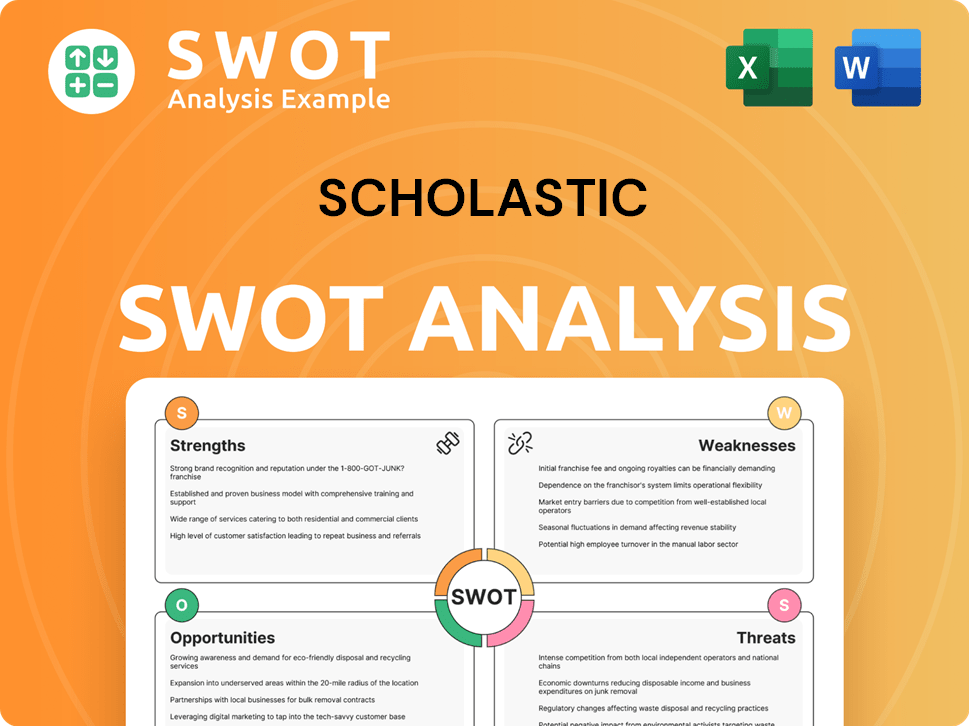
How Does Scholastic Invest in Innovation?
Scholastic is actively leveraging technology and innovation to propel its Scholastic growth strategy, focusing on digital transformation and expanding its media capabilities. This approach is crucial in today's rapidly evolving educational and entertainment landscape. The company's strategic moves aim to capture a larger share of the growing online educational content market.
The company's focus on digital platforms and online learning reflects the changing needs of students and educators. This shift is essential for maintaining Scholastic's future prospects and adapting to the evolving preferences of its audience. By embracing digital technologies, Scholastic aims to enhance its product offerings and broaden its reach.
The acquisition of 9 Story Media Group is a key element of Scholastic's innovation strategy. This strategic move allows Scholastic to expand its presence as a global children's media company. The integration of 9 Story Media Group enables Scholastic to update franchise and licensing plans for its top brands and leverage expertise in digital platforms, such as YouTube.
Scholastic is investing in new technologies and digital platforms to enhance its product offerings. This includes developing new structured literacy programs and supplemental products for schools. These initiatives are designed to meet the evolving needs of students and teachers.
The online educational content market is projected to reach $350 billion by 2025. While print book sales saw a 7% decline in fiscal year 2023, Scholastic is expanding its digital footprint. This strategic shift is vital for long-term growth.
Scholastic Entertainment has launched new channels on advertising-supported distribution platforms. Scholastic's branded channels drew almost 10 million views in February 2025. This demonstrates the company's ability to engage audiences.
Digital book revenues represented only 12% of total book revenues in fiscal year 2023. The company's strategic initiatives aim to meet the evolving needs of students and teachers. These initiatives are scheduled for launch in summer 2025.
The acquisition of 9 Story Media Group is a cornerstone of Scholastic's strategy. This enables Scholastic to expand its opportunities as a global children's media company. This integration allows for an expanded development and production slate.
Scholastic's investment in digital platforms and online learning reflects its commitment to adapting to market trends. The company is focused on expanding its digital footprint to meet the evolving needs of students and teachers. This includes developing new structured literacy programs.
Scholastic's innovation and technology strategy includes digital transformation, expanded media capabilities, and strategic acquisitions. These initiatives are designed to drive Scholastic's revenue growth drivers and maintain its competitive edge. For a deeper look at their marketing strategies, check out the Marketing Strategy of Scholastic.
- Digital Transformation: Investing in online learning platforms and digital content.
- Media Expansion: Leveraging acquisitions like 9 Story Media Group to enhance content offerings.
- Market Adaptation: Responding to the growing demand for online educational content.
- Financial Goals: Aiming to increase digital book revenues and overall market share.
- Strategic Partnerships: Collaborating with other media companies to expand reach.
Scholastic PESTLE Analysis
- Covers All 6 PESTLE Categories
- No Research Needed – Save Hours of Work
- Built by Experts, Trusted by Consultants
- Instant Download, Ready to Use
- 100% Editable, Fully Customizable
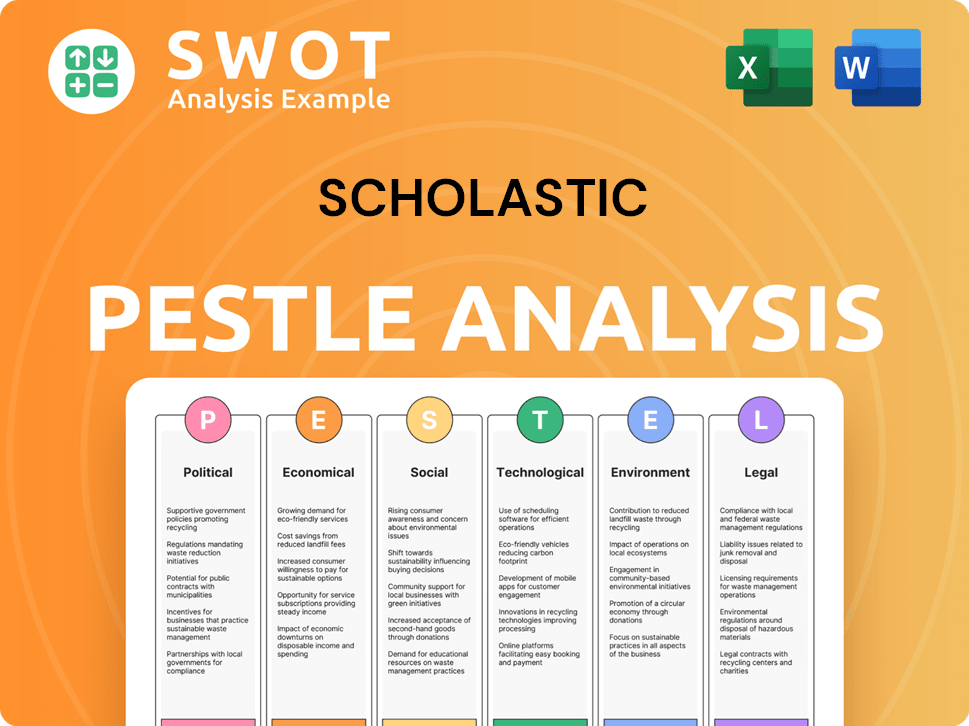
What Is Scholastic’s Growth Forecast?
The financial outlook for the company reflects a focus on modest growth. The company has reaffirmed its guidance for fiscal year 2025, projecting revenue growth between 4% and 6% and an adjusted EBITDA of $140 million to $150 million. However, more recent reports indicate a narrowing of the adjusted EBITDA outlook to approximately $140 million, at the low end of the original guidance, and a forecast for modest full-year revenue growth, down from the prior guidance of 4-6%. This adjustment reflects intensifying spending pressures from families and schools.
In the first quarter of fiscal year 2025, the company reported a 4% year-over-year increase in revenue, reaching $237.2 million, primarily driven by the contribution of 9 Story Media Group. The company's seasonal operating loss improved to $85.6 million from $92.8 million in the prior year. However, Q1 EPS of $1.82 missed the forecast of $2.93, and revenue of $544.6 million also fell short of the $587.06 million forecast, leading to a nearly 10% drop in stock price after the announcement.
For the fiscal second quarter of 2025, the company reported revenues of $544.6 million, a 3% decrease from the prior year, with operating income declining 26% to $74.7 million. Adjusted EBITDA for Q2 also declined by 12% to $108.7 million. The Children's Book Publishing and Distribution segment saw a 6% revenue decline in Q2, with Book Fairs revenue down 5% to $231.0 million, although Book Clubs saw a 2% increase to $33.2 million. The Education Solutions segment experienced a 12% decrease in revenues to $71.2 million. The newly formed Entertainment segment, bolstered by the 9 Story Media Group acquisition, reported revenues of $16.8 million in Q2.
The company initially projected revenue growth between 4% and 6% for fiscal year 2025. However, this has been adjusted to reflect a more modest growth outlook due to economic pressures. Understanding the Target Market of Scholastic is crucial for assessing these shifts.
The adjusted EBITDA guidance for fiscal year 2025 is approximately $140 million, at the low end of the original guidance. This reflects the challenges the company faces in the current market environment. This impacts the overall Scholastic financial performance.
Q1 revenue increased by 4% year-over-year to $237.2 million, with the Entertainment segment contributing significantly. Despite this, Q1 EPS missed forecasts, impacting the stock price. This demonstrates the need to understand the Scholastic's revenue growth drivers.
Q2 revenues decreased by 3% year-over-year to $544.6 million, with a 26% decline in operating income. The Children's Book Publishing and Distribution segment saw a 6% revenue decline. This impacts the Scholastic market share.
In the fiscal third quarter of 2025, revenues increased 4% to $335.4 million, with adjusted EBITDA rising significantly to $6.0 million, a 183% improvement year-over-year. Children's Book Publishing and Distribution saw 5% revenue growth to $203.3 million, with Book Fairs up 8% to $110.7 million and Book Clubs up 14% to $15.2 million. However, Education Solutions revenue dropped 16% to $57.2 million.
- Revenue Growth: 4% increase to $335.4 million.
- Adjusted EBITDA: Increased to $6.0 million, a 183% improvement.
- Book Fairs: Revenue up 8% to $110.7 million.
- Book Clubs: Revenue up 14% to $15.2 million.
The company's net debt was $189.4 million in Q3 fiscal year 2025, compared to a net cash position of $78.9 million in the prior year, primarily due to the 9 Story Media Group acquisition. Despite this, the company returned over $35 million to shareholders in Q3 through dividends ($5.7 million) and share repurchases ($30 million), and also increased its share repurchase authorization to $100 million. The company distributed quarterly cash dividends of $0.20 per share for the first, second, third, and fourth quarters of fiscal year 2025. This shows the Scholastic business model in action.
Scholastic Business Model Canvas
- Complete 9-Block Business Model Canvas
- Effortlessly Communicate Your Business Strategy
- Investor-Ready BMC Format
- 100% Editable and Customizable
- Clear and Structured Layout
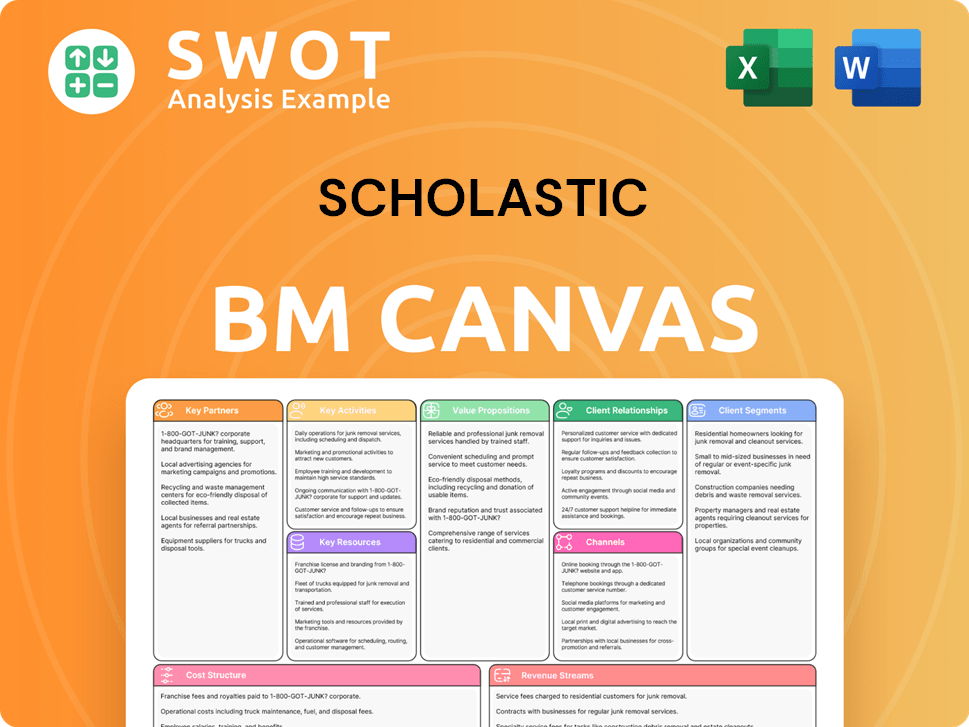
What Risks Could Slow Scholastic’s Growth?
The growth trajectory of the company faces several risks and obstacles. The market saturation, coupled with a downturn in the retail book market, poses a significant challenge to the company's expansion plans in education. Furthermore, the company's financial performance can be affected by difficulties in supplemental curriculum sales and broader macroeconomic factors.
Technological advancements and shifts in consumer behavior are reshaping the educational landscape, creating a need for the company to adapt its business model. Digital learning platforms are gaining market share, and the print book market continues to face challenges. These factors necessitate a strategic response to maintain and enhance the company's market share.
Supply chain vulnerabilities and rising costs in the publishing industry add to the complexities. The company must navigate these challenges while also addressing its dependence on K-12 school purchasing cycles and government education budgets. These factors create vulnerability to funding fluctuations and budget constraints, impacting the company's long-term growth potential.
The company faces market saturation, particularly in the retail book market. This limits the potential for rapid expansion and revenue growth. The company's ability to maintain its competitive position is influenced by market dynamics.
Difficulties in supplemental curriculum sales can significantly impact revenue. The company needs to adapt its offerings to align with evolving educational needs. This segment's performance is crucial to the company's financial health.
Broader macroeconomic factors, such as economic pressures, can affect consumer spending. Economic downturns could lead to reduced spending on educational products. The company's financial performance is sensitive to these economic shifts.
Digital learning platforms are experiencing substantial market share growth, posing a threat. The company's need to adapt to digital learning is crucial for maintaining its market position. The company must invest in its digital transformation strategy.
The print book market continues to face challenges, with digital books representing a small portion of the company's total book revenues. The company's revenue growth drivers must include digital offerings. The company's future in the digital age depends on its ability to adapt.
Supply chain vulnerabilities and rising production and distribution costs are significant obstacles. The publishing industry faced an estimated 11.4% overall production cost increase in 2023. These factors can impact profitability.
The company is vulnerable to K-12 school purchasing cycles and government education budgets. Fluctuations in funding and budget constraints can significantly affect revenue. The company's financial performance is tied to these cycles.
The company is assessing risks through a strategic review of its Education Solutions business. Management is actively managing costs by reducing discretionary expenses and freezing hiring. These efforts are aimed at improving long-term success.
For more insights into the company's core values and mission, you can refer to the article on Mission, Vision & Core Values of Scholastic.
Scholastic Porter's Five Forces Analysis
- Covers All 5 Competitive Forces in Detail
- Structured for Consultants, Students, and Founders
- 100% Editable in Microsoft Word & Excel
- Instant Digital Download – Use Immediately
- Compatible with Mac & PC – Fully Unlocked
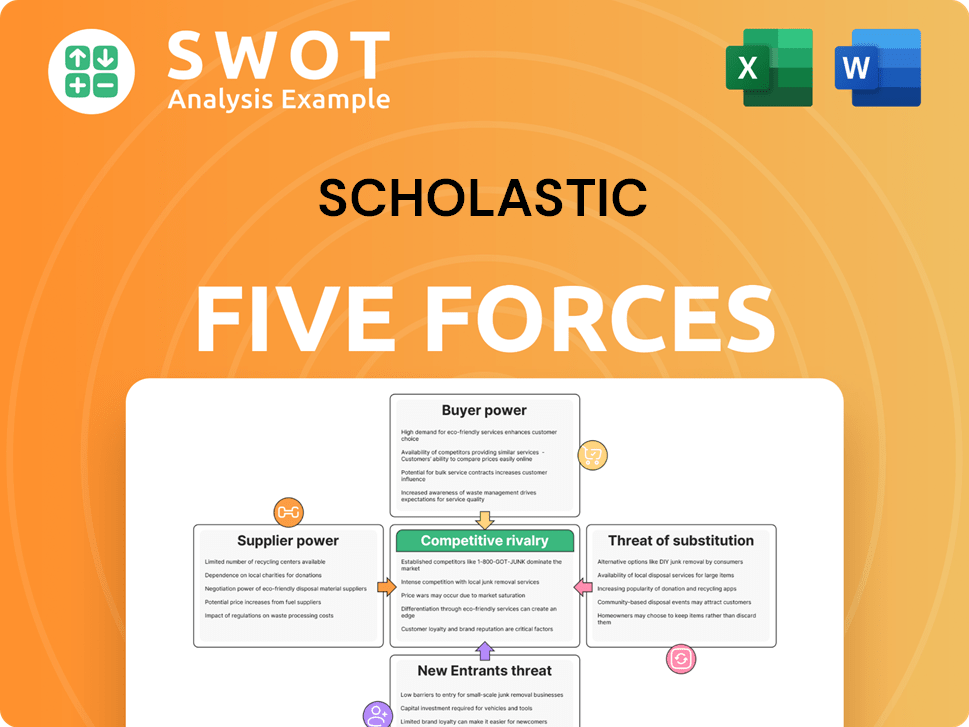
Related Blogs
- What are Mission Vision & Core Values of Scholastic Company?
- What is Competitive Landscape of Scholastic Company?
- How Does Scholastic Company Work?
- What is Sales and Marketing Strategy of Scholastic Company?
- What is Brief History of Scholastic Company?
- Who Owns Scholastic Company?
- What is Customer Demographics and Target Market of Scholastic Company?
Disclaimer
All information, articles, and product details provided on this website are for general informational and educational purposes only. We do not claim any ownership over, nor do we intend to infringe upon, any trademarks, copyrights, logos, brand names, or other intellectual property mentioned or depicted on this site. Such intellectual property remains the property of its respective owners, and any references here are made solely for identification or informational purposes, without implying any affiliation, endorsement, or partnership.
We make no representations or warranties, express or implied, regarding the accuracy, completeness, or suitability of any content or products presented. Nothing on this website should be construed as legal, tax, investment, financial, medical, or other professional advice. In addition, no part of this site—including articles or product references—constitutes a solicitation, recommendation, endorsement, advertisement, or offer to buy or sell any securities, franchises, or other financial instruments, particularly in jurisdictions where such activity would be unlawful.
All content is of a general nature and may not address the specific circumstances of any individual or entity. It is not a substitute for professional advice or services. Any actions you take based on the information provided here are strictly at your own risk. You accept full responsibility for any decisions or outcomes arising from your use of this website and agree to release us from any liability in connection with your use of, or reliance upon, the content or products found herein.